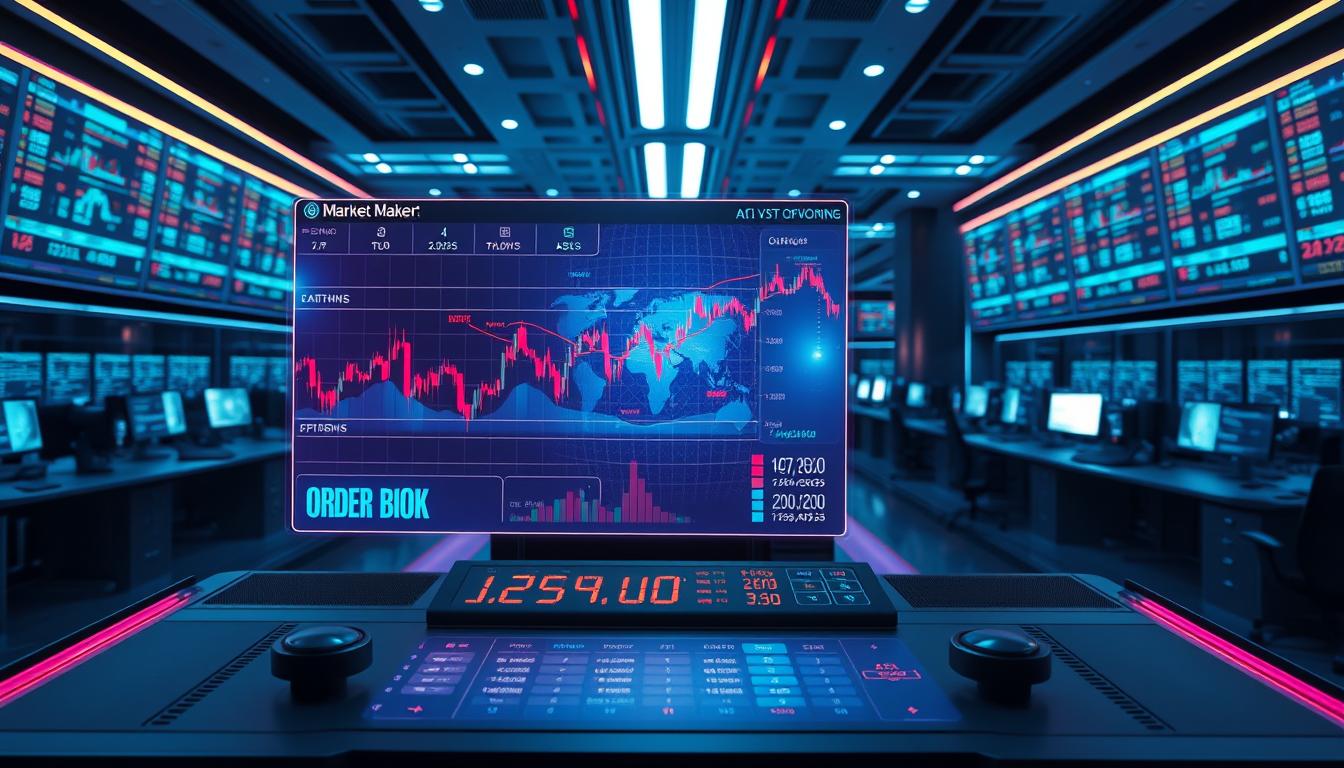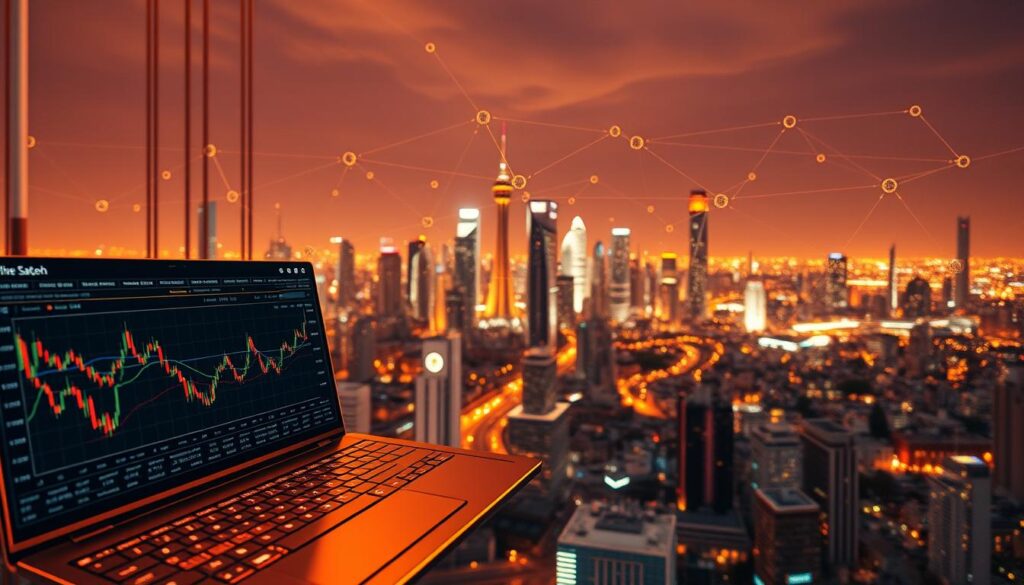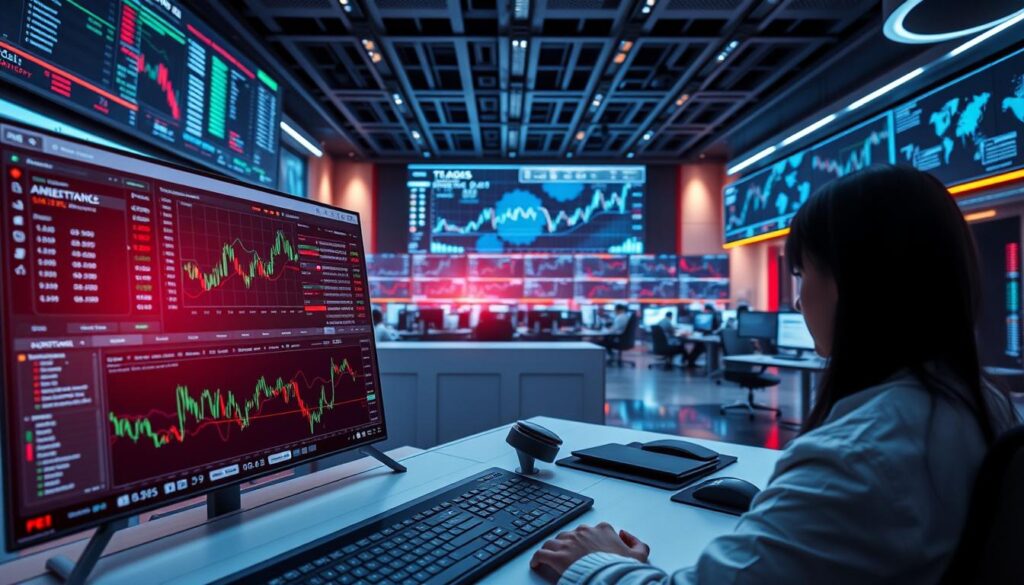Now Reading: How AI Crypto Automated Market Maker Enhances Crypto Trading
- 01
How AI Crypto Automated Market Maker Enhances Crypto Trading
How AI Crypto Automated Market Maker Enhances Crypto Trading

Trading digital assets has changed a lot. Gone are the days when you needed a complex order book. Now, technology handles the heavy lifting.
These new systems are a core part of decentralized finance. They let people swap tokens directly with a pool of funds. This is a big shift from traditional finance.
The idea started to gain real traction around 2017. Platforms like Bancor introduced the concept. Then, Uniswap made it simple for everyone in 2020.
Today, these protocols are essential. They support billions of dollars in daily trades. This shows their massive importance in the ecosystem.
Now, innovation is taking the next step. By adding intelligent algorithms, these systems are getting smarter. They can predict flows and optimize trading for better results.
Key Takeaways
- Automated market makers allow for trustless trading without traditional order books.
- They are a fundamental building block of the decentralized finance landscape.
- These systems have evolved significantly since their introduction, handling immense volume.
- The core difference lies in using algorithmic pricing instead of centralized order matching.
- Intelligent technology is enhancing these protocols beyond their basic formulas.
- This evolution leads to greater efficiency and lower costs for users.
Overview of AI Crypto Automated Market Maker
The core innovation in decentralized finance was replacing order books with self-executing contracts and shared pools of funds. These systems, known as automated market makers, allow direct peer-to-contract trading. Users swap tokens directly from their wallets.
Defining the Concept
Instead of matching individual buy and sell orders, these protocols use liquidity pools. These are collections of tokens supplied by users, called liquidity providers. Prices are set by a mathematical formula, not by the highest bid and lowest ask.
This creates a constantly available market. It democratizes access, letting anyone contribute assets and earn fees from trading activity. The entire process runs on code, ensuring transparency and reducing counterparty risk.
Benefits in the Modern Crypto Landscape
The advantages of this model are significant. Continuous trading availability is a primary benefit, as pools are always open. This leads to improved price discovery and can reduce slippage for traders.
For the ecosystem, it enables greater capital efficiency. Liquidity providers earn passive income, fueling the growth of decentralized finance platforms. This represents a major shift from traditional, centralized finance models.
Core Concepts of Automated Market Makers (AMMs)
Decentralized exchanges rely on mathematical formulas to determine asset values, creating a new paradigm for digital asset trading. These systems eliminate traditional order books through innovative approaches.
Understanding Pricing Models and Liquidity Pools
The constant product formula serves as the foundation for many automated market makers. This mathematical rule maintains that x × y = k, where x and y represent token quantities in a pool.
When users execute buy sell transactions, the formula automatically adjusts prices. This mechanism ensures continuous liquidity without manual intervention.
Liquidity pools contain token pairs supplied by participants. These decentralized reserves enable instant trading for all users.
Role of Smart Contracts
Smart contracts automate the entire trading process from start to finish. They execute trades based on predefined mathematical rules.
These self-executing agreements ensure transparency and security. Every transaction remains visible on the blockchain for verification.
Liquidity providers earn fees by providing liquidity to these pools. This creates economic incentives for maintaining robust trading ecosystems.
The Evolution of AMMs in Decentralized Finance
Before the current sophisticated systems existed, pioneers laid the foundation for today’s trading infrastructure. The concept emerged during the early growth of decentralized finance.
From Bancor to Uniswap and Beyond
In 2017, Bancor introduced the first working model of these protocols. It demonstrated that liquidity pools could replace traditional order book systems. This was a major breakthrough for peer-to-peer trading.
Uniswap’s arrival in 2020 marked the next evolutionary step. It simplified the user experience dramatically. The platform used an elegant mathematical formula that became the industry standard.
The success inspired numerous variants with specialized features:
- Curve Finance optimized stablecoin trading
- Balancer introduced multi-token pools
- SushiSwap added community governance elements
Each generation addressed previous limitations. They improved capital efficiency and reduced trading costs. Today, these systems handle massive volume across the decentralized exchange landscape.
The evolution continues with advanced features like dynamic fees and concentrated liquidity. These innovations make automated market makers more efficient than ever before.
Enhancing Market Efficiency with AI-Driven Trading Strategies
The next frontier for decentralized trading lies in integrating intelligent algorithms that learn from market behavior. These systems move beyond basic formulas to create more responsive and efficient environments.

This evolution significantly boosts market efficiency. It allows protocols to adapt dynamically instead of relying on static rules.
How Machine Learning Improves Trade Execution
Machine learning models analyze historical data and real-time conditions. They identify patterns in trading volume and price movements.
This analysis enables more accurate forecasts. Systems can predict where liquidity will be needed most.
Advanced frameworks like LSTM networks handle complex time-series data. Reinforcement learning techniques, such as Q-learning, allow systems to test and refine their trading strategies.
The goal is proactive adjustment. Liquidity can be concentrated in anticipated price ranges before major shifts occur.
This intelligent approach contrasts sharply with earlier methods. The table below highlights key differences.
| Feature | Traditional AMM | Intelligent System |
|---|---|---|
| Pricing Model | Static Formula (e.g., x*y=k) | Dynamic, Predictive Algorithm |
| Liquidity Management | Fixed across a wide range | Concentrated in forecasted ranges |
| Adaptation | Manual updates or community governance | Continuous, automated optimization |
| Primary Goal | Basic token swap functionality | Maximized capital efficiency and reduced slippage |
Hybrid architectures make this possible. They use on-chain settlement for security but perform complex machine learning computations off-chain. This balance provides both safety and powerful analytical capabilities for improved trade execution.
Understanding Liquidity Pools and Price Determination
Price discovery in decentralized systems operates on a fundamentally different principle than traditional markets. Instead of order books, these platforms use mathematical formulas to determine values automatically.
The system relies on shared reserves called liquidity pools. Users contribute tokens to these pools, enabling continuous trading for everyone.
Mechanisms Behind Constant Product Formula
The most common pricing model uses the constant product formula: x × y = k. This simple equation maintains that the product of two token quantities in a pool remains unchanged.
When someone executes a trade, the formula automatically adjusts asset prices. Larger transactions create greater price impact due to the mathematical relationship.
This mechanism ensures liquidity invariance across all conditions. The pool never runs out of either token, though exchange rates fluctuate with each transaction.
The table below shows how trade size affects price determination in different pool conditions:
| Trade Size | High Liquidity Pool | Low Liquidity Pool |
|---|---|---|
| Small Trade | Minimal price change | Moderate price impact |
| Medium Trade | Noticeable price adjustment | Significant price movement |
| Large Trade | Substantial price impact | Major price shift |
Providing liquidity requires depositing equal values of both tokens in a pair. This balanced approach maintains the constant product relationship across all price ranges.
Mitigating Risks: Slippage and Impermanent Loss
Successful participation in token exchange platforms involves navigating specific financial risks that can impact returns. Two primary concerns emerge for different participants in these systems.
Traders face slippage when executed prices differ from expected values. This occurs due to liquidity depth and order size during transaction processing.

Strategies to Reduce Trading Impact
The price impact of transactions relates directly to trade size relative to pool reserves. Larger trades cause greater price changes due to mathematical formulas governing asset ratios.
Practical approaches minimize this effect. Breaking large trades into smaller orders spreads the price impact over time. Trading during periods of high liquidity provision also helps reduce slippage.
Setting appropriate tolerance parameters protects against unfavorable executions. Monitoring current market conditions allows for strategic timing of transactions.
Risk Management for Liquidity Providers
Those who provide liquidity face impermanent loss when token values diverge. This temporary reduction occurs compared to simply holding assets separately.
Effective management involves selecting stable pairs and appropriate price ranges. Active monitoring of price fluctuations helps adjust liquidity positions as needed.
Trading fees earned through liquidity provision can offset potential losses. Longer investment horizons may reduce the impact as prices often revert toward original ratios.
Smart Contracts and Security Benefits in AMMs
Security in token trading platforms is fundamentally reshaped by self-executing code running on distributed networks. These digital agreements create environments where trust comes from mathematics rather than middlemen.
Smart contracts handle every aspect of trading automatically. They calculate prices, process swaps, and distribute fees without human input. This automation reduces errors and operational costs significantly.
Automation and Trust in Blockchain
These contracts operate on the Ethereum blockchain, providing a secure foundation. The code is immutable once deployed, meaning rules cannot change unexpectedly. Participants can verify all operations through transparent blockchain records.
The security advantages are substantial. Systems built with smart contracts resist single points of failure. They also prevent censorship since no central authority controls transactions.
This table highlights key security differences:
| Security Feature | Traditional Systems | Smart Contract Systems |
|---|---|---|
| Transaction Verification | Manual approval processes | Automated cryptographic checks |
| Code Transparency | Proprietary, hidden logic | Open-source, auditable code |
| System Availability | Subject to downtime | 24/7 blockchain operation |
| Rule Enforcement | Human-dependent | Mathematically guaranteed |
Developers must address potential vulnerabilities through careful coding practices. Regular audits help ensure these automated market makers remain secure for all users.
Blockchain Integration and Transparency in DeFi Markets
Public verifiability of all transactions distinguishes decentralized systems from their centralized counterparts. This transparency represents a core advantage in decentralized finance ecosystems.
Traditional platforms rely on off-chain settlement with trusted intermediaries. These centralized exchanges face challenges like server downtime and uncertain execution quality.
Decentralized exchanges eliminate these concerns through blockchain integration. Every transaction becomes part of an immutable public record.
| Feature | Centralized Exchange | Decentralized Exchange |
|---|---|---|
| Transaction Visibility | Limited to platform records | Fully transparent on blockchain |
| Custody | Assets held by exchange | User maintains control |
| Settlement | Off-chain, delayed | On-chain, immediate |
| Counterparty Risk | High (trust required) | Eliminated (trustless) |

Market participants can verify every aspect of trading activity. This includes trading volume, liquidity distribution across token pairs, and complete audit trails.
The elimination of traditional order books reduces complexity significantly. Automated market protocols enable direct peer-to-contract interactions.
Popular decentralized exchanges now offer high liquidity rivaling centralized platforms. All buy sell transactions remain publicly verifiable and cryptographically secured.
AI crypto automated market maker: Technology and Benefits
Sophisticated predictive capabilities are transforming how liquidity moves across digital trading platforms. These enhanced systems represent the next evolution in decentralized trading infrastructure.
Traditional protocols rely on static mathematical formulas for price determination. Intelligent systems incorporate dynamic algorithms that learn from market patterns.
Integrating AI with Traditional AMM Models
Enhanced frameworks combine on-chain settlement with off-chain computational power. This hybrid approach maintains blockchain security while enabling complex analysis.
Machine learning models process historical trading data and real-time conditions. They identify patterns in trading volume and asset price movements.
The table below shows how enhanced systems improve upon traditional approaches:
| Feature | Traditional System | Enhanced System |
|---|---|---|
| Price Determination | Static formula-based | Dynamic, predictive modeling |
| Liquidity Positioning | Fixed across wide ranges | Concentrated in forecasted zones |
| Adaptation Speed | Manual or governance-based | Continuous automated optimization |
| Capital Efficiency | Basic utilization | Maximized through forecasting |
Optimizing Liquidity Provision with Data-Driven Insights
Predictive models analyze where trading activity will likely occur. This allows proactive positioning of tokens liquidity before major price movements.
Liquidity providers benefit from reduced divergence loss through better capital allocation. Traders experience lower price impact during transactions.
Continuous learning algorithms ensure systems adapt to changing market conditions. This creates more efficient decentralized exchanges for all participants.
Optimizing Liquidity Provision and Order Execution
Advanced protocols now enable liquidity providers to target specific price ranges rather than spreading capital across all possible values. This approach dramatically improves capital efficiency across the entire liquidity market.
Specific Price Ranges and Concentrated Liquidity
Concentrated liquidity allows providers to focus their tokens liquidity within chosen price ranges. This strategy multiplies capital efficiency by concentrating funds where trading activity occurs most frequently.
Providers can analyze token pair volatility patterns to select optimal specific price ranges. When prices remain within these ranges, providers earn significantly higher fees with less capital commitment.
| Feature | Traditional Liquidity Provision | Concentrated Liquidity |
|---|---|---|
| Capital Deployment | Spread across entire price spectrum | Focused on specific price ranges |
| Efficiency Multiplier | Basic 1:1 ratio | Up to 100x improvement |
| Fee Earnings | Diluted across wide range | Concentrated in active zones |
| Risk Profile | Lower but consistent | Higher but targeted returns |
Active management of liquidity positions ensures optimal placement as market conditions evolve. Regular adjustments maintain high liquidity at key price points, reducing slippage for traders.
This concentrated approach represents a fundamental advancement in liquidity provision strategies. It enables smaller capital bases to support substantial trading volumes effectively.
Advanced Trading Strategies Powered by AI
Modern trading platforms now employ predictive frameworks that continuously evolve based on real-time data analysis. These sophisticated approaches represent a significant advancement beyond traditional mathematical formulas.
Predictive Reinforcement Learning Approaches
Long Short-Term Memory networks analyze temporal patterns in asset price movements. They forecast where trading activity will likely concentrate.
Reinforcement learning algorithms enable systems to learn optimal policies through trial and error. Q-learning frameworks interact with trading environments to improve decision-making over time.
Hybrid approaches combine predictive capabilities with decision optimization. This creates robust trading strategies that adapt to changing market conditions.
The table below shows how advanced systems differ from traditional approaches:
| Feature | Traditional Approach | Advanced Framework |
|---|---|---|
| Learning Method | Static rules | Continuous adaptation |
| Price Prediction | Basic formulas | Neural network analysis |
| Liquidity Positioning | Fixed ranges | Dynamic optimization |
| Response to Changes | Delayed updates | Immediate adjustment |
These intelligent frameworks evaluate countless scenarios to identify optimal management strategies. They anticipate shifts in price ranges before major movements occur.
This proactive approach improves capital utilization and reduces risks for participants. Systems continuously learn from market feedback to enhance performance.
Market Impact: Trading Volume, Gas Fees, and Capital Efficiency
Economic performance metrics reveal critical insights into the operational dynamics of decentralized trading systems. These factors directly influence profitability for both traders and liquidity providers.
Uniswap demonstrated remarkable scale in September 2023, processing $19.4 billion in monthly trading volume. This substantial activity highlights the growing adoption of these platforms.

Assessing Costs and Efficiency in Real Time
Gas fees represent transaction costs that vary based on network congestion. Complex smart contract interactions require more computational resources, increasing expenses.
These costs disproportionately affect smaller transactions. Traders must consider both price impact and gas fees when planning large trades.
Capital efficiency measures how effectively deployed funds generate returns. Higher trading volume through concentrated positions creates more fees per capital unit.
| Factor | Traditional Exchange | Decentralized Exchange |
|---|---|---|
| Trading Volume Impact | Centralized order book matching | Algorithmic price determination |
| Fee Structure | Fixed percentage commissions | Gas fees + liquidity provider fees |
| Capital Efficiency | Moderate with manual management | High with concentrated liquidity |
| Cost for Large Trades | Primarily price slippage | Slippage + significant gas fees |
Real-time monitoring helps participants optimize strategies. Understanding price fluctuations and market conditions enables better decision-making for all trades executed.
Hybrid AMM Models: Concentrated Liquidity and Dynamic Fees
Hybrid models in decentralized finance combine the best features of different protocols to create specialized solutions. These advanced systems address specific trading needs through innovative mechanisms.
They optimize performance for various asset types and use cases. Each platform offers unique advantages for different scenarios.
Insights from Leading Protocols
Curve Finance specializes in stablecoin trading with custom bonding curves. This approach minimizes slippage for correlated token pairs with minimal price changes.
Uniswap V3 transformed capital efficiency through concentrated liquidity. Providers can focus funds in specific price ranges where trading occurs most frequently.
Balancer enables multi-token pools with flexible weightings. This architecture supports complex asset allocation and automated rebalancing strategies.
Dynamic fee structures adjust costs based on market conditions. This improves both trader experience and provider returns across different volatility levels.
| Protocol | Specialization | Key Innovation | Best For |
|---|---|---|---|
| Curve Finance | Stablecoin trading | Custom bonding curves | Correlated assets |
| Uniswap V3 | General trading | Concentrated liquidity | Volatile pairs |
| Balancer | Portfolio management | Multi-token pools | Diversified allocation |
These hybrid approaches demonstrate how learning from different protocols enables optimized design. Each system addresses specific limitations while maximizing efficiency for its intended use case.
Evolving Role of Machine Learning in AMM Development
Continuous optimization represents the next evolutionary step in managing digital asset liquidity. Advanced computational systems now enhance traditional approaches to liquidity provision.
These systems analyze vast datasets to improve capital efficiency across trading platforms. They identify patterns that human operators might otherwise miss.
Continuous Liquidity Optimization
Machine learning frameworks enable real-time adjustment of liquidity positions. They monitor asset prices and trading volume continuously.
This approach maintains high liquidity levels with optimized capital allocation. The system dynamically repositions resources as market conditions evolve.
Reinforcement learning allows systems to adapt strategies based on market feedback. Deep learning models process historical data to forecast optimal positioning.
| Feature | Traditional Approach | Machine Learning System |
|---|---|---|
| Position Adjustment | Manual or scheduled | Continuous, real-time |
| Pattern Recognition | Basic statistical analysis | Complex pattern detection |
| Response Time | Hours or days | Seconds or minutes |
| Capital Efficiency | Moderate optimization | Maximum utilization |
Liquidity providers benefit from automated management of their positions. The system handles complex decisions across multiple price ranges simultaneously.
This intelligent liquidity management reduces manual intervention requirements. It also minimizes opportunity costs during rapid market movements.
Real-World Case Studies and Future Outlook
Examining real-world implementations reveals critical insights into decentralized finance evolution. Leading platforms demonstrate how innovative designs address practical challenges.
Protocols like Uniswap, Curve, and Balancer have developed unique approaches to liquidity management. Each platform offers distinct advantages for different trading strategies.
Lessons from Leading DeFi Platforms
Uniswap’s progression shows how concentrated liquidity improves capital efficiency. The platform handles substantial trading volume through optimized positioning.
Curve Finance specializes in stable assets with minimal price changes. Its design reduces slippage for correlated token pairs effectively.
Balancer enables complex portfolio management through multi-token pools. This approach supports diversified allocation strategies.
| Platform | Key Strength | Impact on Trading |
|---|---|---|
| Uniswap V3 | Concentrated liquidity | Higher capital efficiency |
| Curve Finance | Stablecoin optimization | Reduced slippage |
| Balancer | Flexible pool weights | Portfolio management |
Innovative Trends in Crypto Trading
Future developments focus on adaptive systems that respond to market conditions. These platforms will optimize liquidity provision automatically.
Enhanced management strategies will help participants navigate price changes more effectively. The ecosystem continues evolving toward greater accessibility.
Providers can expect better tools for decision-making as technology advances. These improvements will benefit all participants in decentralized finance.
Conclusion
As we conclude our exploration of modern trading infrastructure, the transformative power of algorithmic systems becomes evident. These innovations have reshaped how participants interact with digital assets.
The evolution of automated market makers demonstrates significant progress in decentralized finance. Understanding core mechanisms like liquidity pools and smart contracts remains essential for effective participation.
Modern market makers address traditional challenges through intelligent positioning. This leads to reduced costs and improved efficiency for all users.
The future of decentralized finance continues to evolve with predictive technologies. These systems represent the next generation of efficient trading infrastructure.
FAQ
What is an automated market maker?
An automated market maker is a protocol that uses smart contracts to create a liquidity pool for token pairs. It replaces traditional order books with a mathematical formula for price determination, enabling continuous trading on decentralized exchanges.
How does a liquidity pool work?
A liquidity pool is a smart contract that holds reserves of two or more tokens. Users, called liquidity providers, deposit these assets. The pool’s algorithm, like the constant product formula, automatically sets prices based on the ratio of tokens, facilitating buy and sell orders.
What is impermanent loss?
Impermanent loss occurs when the price of tokens in a liquidity pool changes compared to when they were deposited. It represents the temporary loss a liquidity provider might face versus simply holding the assets, highlighting a key risk in liquidity provision.
How do smart contracts ensure security?
Smart contracts automate all operations on the blockchain, executing trades and managing funds based on predefined, transparent code. This reduces the need for trust in a central authority and minimizes human error, enhancing security in decentralized finance.
What is concentrated liquidity?
Concentrated liquidity is an advanced feature, pioneered by platforms like Uniswap v3, that allows providers to allocate capital within specific price ranges. This increases capital efficiency and can lead to higher fees earned for providing liquidity where it’s most needed.
How does AI improve these systems?
By integrating machine learning, these systems can analyze vast amounts of data on trading volume and price fluctuations. This enables predictive reinforcement learning approaches to optimize liquidity management strategies, reduce slippage on large trades, and improve overall market efficiency.
What are the benefits of using a decentralized exchange?
Decentralized exchanges offer non-custodial trading, meaning users maintain control of their assets. They provide global access, resistance to censorship, and transparency through on-chain settlement, though users should be mindful of gas fees on networks like the Ethereum blockchain.













